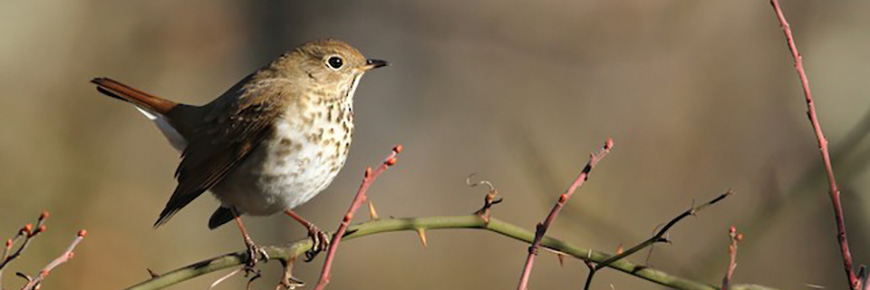Across the far reaches of America, the English language is spoken in colorful variation. If you’re Texan, I reckon y’all fixin’ for some coke in this summer heat, but as a Michigander, yuh guys go tuh gedduh pop. New Yorkers and Bostonians drink soda, but some wicked wee-id Bostonians drink tonic, while some New Yorkers prefer cawwfee or watta in any weather. Much like how the many dialects arose in American English, bird song can also evolve regional dialects. Over the past one million years, the Hermit Thrush (Catharus guttatus) has gone through a comparable evolution – although perhaps not as strange.
The Hermit Thrush has evolved into three genetically and physically distinct groups. During the Pleistocene era, the same glacial ice that created the Great Lakes and the Finger Lakes of New York covered North America and created a physical barrier between the species’ eastern and western breeding ranges. These isolated populations evolved into two genetically distinct groups: the Northern group stretches from British Columbia towards the eastern U.S., and the western group spans the western mountain ranges of the U.S. A later glacial advance further divided the western group into the Western Lowland, along the Pacific coast, and Western Mountain, in the Rocky Mountains, groups.
Modern migration patterns prevent the three groups of Hermit Thrush from interbreeding, which helps maintain their physical distinctions. Western Lowland individuals tend to be smaller and thinner-billed than the Western Mountain group, while Northern birds are medium-sized with thicker bills. Pacific birds’ plumage is a darker tawny than Northern birds, while the Western Mountain individuals are a characteristic gray.

Across the three groups, the males’ songs begin with a single introductory note, followed by a complex series of notes. Pitch and song length differ between populations recorded in Arizona and New England, but until recently, scientists did not know how these variations in Hermit Thrush song extended across the breeding ranges. Using recordings from Macaulay Library, xeno-canto, Michigan State University’s Avian Vocalization Center, the Ohio State Borror Laboratory of Bioacoustics, and independent recordists, researchers Sean Roach and Leslie Phillmore of Dalhousie University compared Hermit Thrush songs from across the bird’s breeding ranges to find out.
Hermit Thrush Catharus guttatus, New York, 1951 © Arthur A. Allen and Peter Paul Kellogg ML 3675. This recording may have been used in the study.
Hermit Thrush Catharus guttatus, California, 2006 © Gregory Budney ML48265131. This recording may have been used in the study.
Roach and Phillmore1 compared songs from 101 individual Hermit Thrushes using pitch and song duration. After pairing each recording’s location with climate data—including precipitation, temperature, and altitude—they could characterize each individual’s habitat.
Their results show that each of the Hermit Thrush’s geographic regions correlates with a different song structure. For example, the northern birds sing shorter introductory notes with a larger pitch range than western birds, while the post-introductory notes of northern birds were longer. They also found sub-levels of diversity within the western group that relate to habitat and altitudinal range, like birds with an unusually low-pitched song inhabiting a particularly dry area of the Pacific Coast range.

Roach and Phillmore concluded that several factors shape the Hermit Thrush song, particularly large-scale geological events. The differences in the introductory notes between the eastern and the western groups likely resulted from the initial separation during the Pleistocene era. But more than geographical separation can affect song. Sometimes, entire populations will learn mistakes in just a few individuals’ songs, resulting in a sort of accidental regional dialect. This phenomenon, called cultural drift, can create communicative divides, and prevent interactions between groups. Cultural drift may have created sub-groups within the Western Lowland and Western Mountain sub-groups, in tandem with divergent migration patterns.
Despite these new understandings, the researchers continue to speculate about what other selection pressures influence Hermit Thrush song. Among the Northern group, birds recorded at higher elevations had higher pitched notes. Roach and Phillmore know that lower-pitched songs might travel faster through dense forests, while higher pitches might travel farther in open fields. At high elevations, there are more shrubs than trees, creating more open landscapes. Some regions of the Western Lowland birds have much more annual rainfall than others. And in a wetter climate, bird song takes on a higher pitch to be heard over frequent rainfall—which may explain some variation in the Hermit Thrush’s western diversity. So, habitat type may play an important role in song evolution.
While the authors can only speculate what exact pressures have influenced the Hermit Thrush’s evolving song, they now have a roadmap to the bird’s North American vernaculars.




